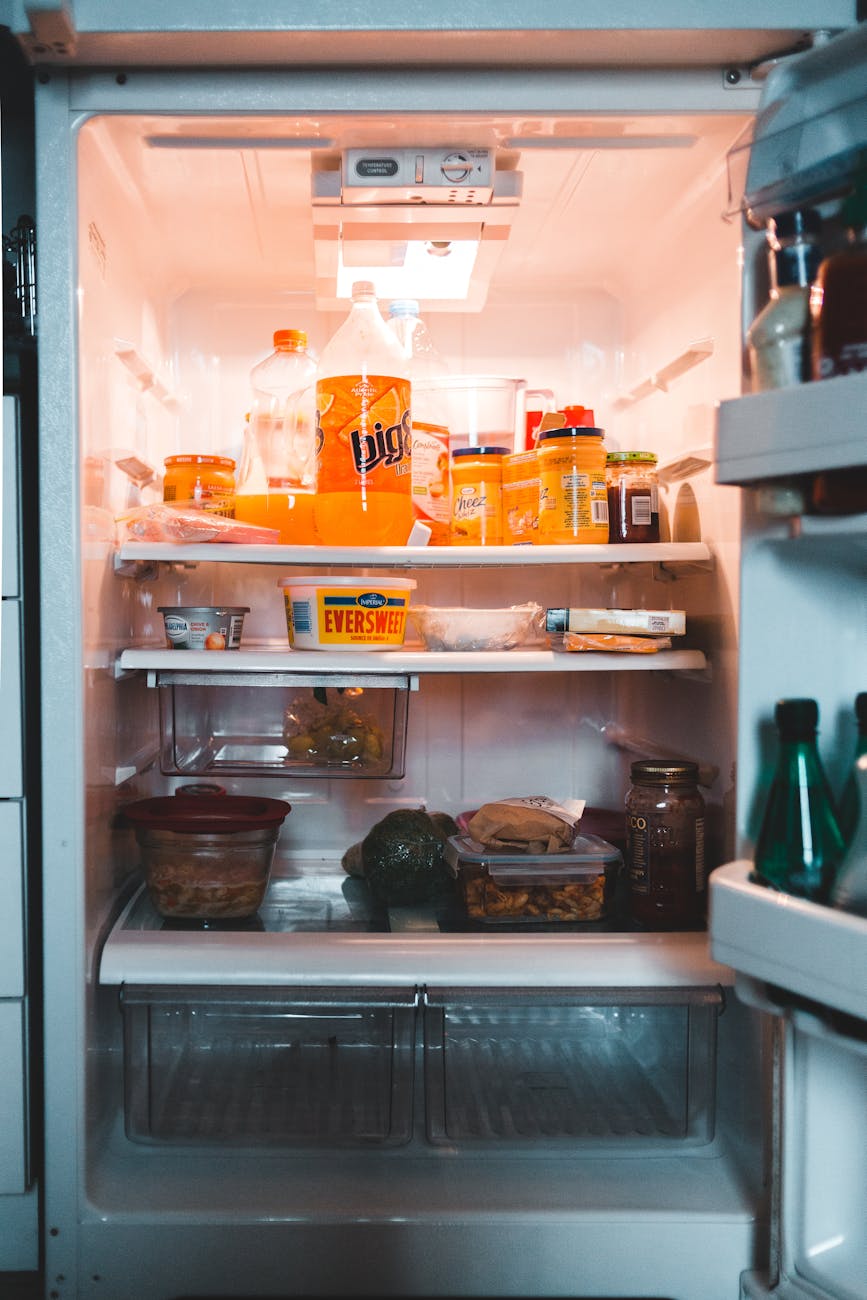The Art of Fridge Organization
Organizing your fridge may seem like a mundane task, but it's a key component in transforming your kitchen into a haven of efficiency and food safety. By mastering the art of fridge organization, you can optimize your food storage and ensure that your household runs more smoothly.
Importance of Organizing Your Fridge
You might not realize it, but the way you arrange your fridge can have a significant impact on your daily routine. A well-organized fridge streamlines meal preparation, saves time during food searches, and helps prevent spoilage by making it easier to spot items that need to be consumed first. Proper organization can also maximize space, making your fridge feel bigger than it is.
Benefits of a Well-Organized Fridge
The benefits of having an orderly fridge are numerous. Here are a few key advantages:
-
Food Safety: By storing food correctly, you reduce the risk of cross-contamination and ensure that everything is kept at the right temperature to prevent bacterial growth. For more on food safety, see mastering food safety understanding chicken's shelf life in the fridge.
-
Less Waste: When you can see all your food items clearly, you're less likely to let things go bad. This means fewer items thrown out and more money saved.
-
Energy Efficiency: A cluttered fridge works harder, consuming more energy. Organizing helps air circulate better, which can lower your electric bill.
-
Stress Reduction: Searching for ingredients in a disorganized fridge can be stressful. An organized fridge brings a sense of calm to your kitchen. For those interested in retro aesthetics and stress-free environments, refer to retro revival explore the world of retro look refrigerators.
By understanding the importance and benefits of fridge organization, you're on your way to achieving fridge bliss. Stay tuned to learn how to prepare your fridge for organization and the best practices for maintaining an organized space.
Preparing Your Fridge for Organization
Before you can revel in the benefits of a well-organized fridge, some preliminary steps are essential to ensure you start on the right foot. Preparing your fridge for organization involves a thorough clean-up and evaluation of the available space.
Emptying and Cleaning Your Fridge
The first step in your fridge organization journey is to empty it completely. Remove all food items, shelves, and bins. It's an opportune moment to discard expired or spoiled items and plan to consume or freeze items that are nearing the end of their freshness.
Once emptied, clean the interior with a mild detergent or a natural cleaning solution such as a mixture of water and baking soda. Wipe down all surfaces, including the walls and the rubber door seal, to remove any spills, crumbs, or residues. After cleaning, dry all surfaces thoroughly to prevent the growth of mold or bacteria.
| Fridge Component | Cleaning Solution | Cloth Type |
|---|---|---|
| Interior Walls | Mild detergent or baking soda mix | Soft, non-abrasive |
| Shelves and Bins | Soapy water | Sponge or soft cloth |
| Door Seal | Mild detergent and water | Soft cloth |
Assessing Your Fridge Space
Now that your fridge is clean, assess the space and consider how it can be utilized most effectively. Look at the height between shelves, the number and size of drawers, and door storage capacity. Note the adjustable elements, like shelving tracks or movable bins, which can be tailored to fit your needs.
Measure the dimensions of each section to determine the size of storage bins or organizers you might need. Think about the types of food you typically store and how you can group items to maximize space and access. For example, frequently used items should be placed at eye level for easy reach.
Consider any special features your fridge might have, such as a built-in undercounter freezer or specialized produce drawers. If you are unsure about how to manage certain food items' storage, consult guides like how long does curry stay fresh in the fridge or understanding chicken's shelf life in the fridge to ensure optimal placement.
| Fridge Area | Dimension (W x D x H) | Notes |
|---|---|---|
| Top Shelf | 24" x 18" x Adjustable | Ideal for drinks and ready-to-eat foods |
| Middle Shelf | 24" x 18" x Adjustable | Can be adjusted for tall items |
| Bottom Shelf | 24" x 18" x Adjustable | Often coldest; good for raw meat storage |
| Drawers | Varies | Specialized humidity controls for produce |
| Door Bins | Varies | Suited for condiments, juices, and more stable items |
By thoroughly emptying and cleaning your fridge, followed by an assessment of the available space, you lay the foundation for a well-organized refrigerator. The next steps will involve categorizing your items and optimizing the layout for efficiency and ease of use, ensuring you are well on your way to unlocking fridge bliss.
Categorizing and Grouping
Optimizing refrigerator storage begins with efficient categorization and grouping of items. This not only makes it easier to locate what you need but also helps maintain food freshness and safety.
Grouping Similar Items Together
To create an intuitive organization system, group similar items together. This method simplifies the search process and can help track your inventory at a glance. Consider these common groupings:
- Dairy products such as milk, yogurt, cheese
- Fresh produce, subdivided by fruits and vegetables
- Meats and seafood, separated by type
- Condiments and sauces
- Beverages
- Leftovers and meal-prepped foods
By arranging items based on category, you’ll streamline your kitchen routine and reduce the time spent rummaging through the fridge. For insights on how long certain foods last, including eggs, consult our article on cracking the code how long do eggs last in the fridge.
Utilizing Storage Bins and Containers
Storage solutions such as bins and containers can significantly enhance your refrigerator's functionality. These tools not only keep your fridge tidy but also aid in maintaining the freshness of your groceries. Here’s how you can make the most of them:
- Assign bins for specific categories, such as fruits, vegetables, or snacks.
- Opt for clear containers to easily identify contents without needing to open them.
- Ensure containers are airtight to prolong the shelf life of perishables.
- Stackable bins can maximize vertical space and keep shelves uncluttered.
When incorporating bins and containers, consider the dimensions of your fridge shelves and drawers. Adjustable dividers within bins can offer further customization, accommodating varying sizes of food items. For more advanced organization techniques, explore the benefits of under-counter freezer drawers in our article on organize with ease explore the benefits of under-counter freezer drawers.
Efficiently categorizing and grouping your fridge contents, along with the strategic use of storage aids, can transform your refrigerator into a haven of organization. Not only will this approach save you time, but it will also contribute to prolonging the freshness of your food, ultimately unlocking fridge bliss in your home.
Maximizing Shelf Space
Optimizing Shelf Height
To make the most of your refrigerator's capacity, adjusting shelf height can be a game-changer. Many fridges offer adjustable shelves, allowing you to customize the space to fit larger items such as pitchers, cake stands, or tall bottles. It's important to arrange the shelves in a way that maximizes vertical space without wasting any area above shorter items such as yogurt containers or jars.
Here's a simple guide to help you optimize the shelf height:
| Item Height | Suggested Shelf Setting |
|---|---|
| Under 4 inches | Closest spacing |
| 4 to 8 inches | Medium spacing |
| Over 8 inches | Widest spacing |
Remember, the goal is to accommodate various item heights while avoiding overcrowding. It's also recommended to maintain freshness by setting the right refrigerator temperature for optimal food preservation.
Utilizing Lazy Susans and Fridge Mats
Lazy Susans and fridge mats are fantastic tools for maximizing shelf space and accessibility. A Lazy Susan can be placed on any shelf to make rotating items easy, ensuring that nothing gets lost in the back. This is especially useful for condiments, small containers, or anything you frequently reach for.
Fridge mats, on the other hand, provide a smooth surface that allows items to slide out effortlessly. This is particularly helpful for heavy items that might otherwise be difficult to move. Additionally, mats can make cleanup easier by catching spills or crumbs.
Here are some ways to incorporate Lazy Susans and fridge mats:
- For Condiments and Jars:
- Place a Lazy Susan on the top shelf for easy access to frequently used items.
- For Heavy Items:
- Use fridge mats on lower shelves to slide out heavy pots or beverage containers.
By implementing these tools, you can ensure that every inch of your shelf space is utilized effectively, allowing for a more organized and user-friendly fridge. For more tips on keeping your refrigerator in top shape, explore our guide on efficient storage secrets maximizing the lifespan of rice in the fridge and other food items.
Drawer and Door Organization
Organizing Fridge Drawers
Fridge drawers are your allies in maintaining an orderly refrigerator. They provide dedicated spaces for different types of produce and other items, helping to keep them fresh and accessible. Here's how to optimize your fridge drawers:
- Designate Drawers: Assign specific drawers for fruits, vegetables, meats, and cheeses. This separation minimizes cross-contamination and helps maintain the appropriate humidity levels for each type of food.
- Regulate Humidity: Adjust the humidity settings if your fridge drawers have controls. High humidity for leafy greens and low humidity for fruits will keep them in peak condition.
- Use Drawer Dividers: Consider investing in adjustable dividers to further categorize items within the drawers. This can prevent smaller items from getting lost or forgotten.
By organizing your fridge drawers, you create an environment where every item has its place, making it easier to find what you need and maintain freshness.
Utilizing Door Storage
Door storage areas are excellent for holding condiments, juices, and other items that do not require the coldest part of your fridge. Here's how to make the most out of these spaces:
- Condiments and Sauces: Allocate the door shelves for jars and bottles. The doors are the warmest part of the fridge, which is acceptable for these items.
- Dairy Products: Some fridges have a dairy compartment on the door; use this for butter and soft cheeses.
- Drinks: Store juices, sodas, and water on the door shelves. However, remember that milk should be kept inside the fridge where it's cooler.
Remember, heavy items like gallons of milk can cause door shelves to sag or break over time. It's best to place them on the main shelves. Utilize door storage wisely to ensure that items are kept at their ideal temperatures and are easy to access.
By attending to the organization of your fridge drawers and doors, you unlock the potential for a more efficient and blissful kitchen experience. This optimization not only contributes to the longevity of your groceries but also streamlines your daily routine. For more insightful tips on fridge organization, explore our articles on preserving pasta perfection and unlocking fridge bliss.
Temperature Zones and Placement
Effectively organizing your refrigerator involves understanding the different temperature zones and the optimal placement for various food items. This knowledge ensures that your food is stored under the best conditions to maintain freshness and flavor.
Understanding Temperature Zones in Your Fridge
Your refrigerator is designed with specific temperature zones, each suited for different types of food. The coldest part is usually the bottom and the back of the fridge, while the warmest areas are the door shelves and the upper shelves.
- Upper Shelves: These are typically the warmest part due to their proximity to the fridge's opening. They're ideal for foods that do not require cooking, such as deli meats and leftovers.
- Lower Shelves: The lower shelves are cooler and perfect for storing raw meat, poultry, and fish, which need lower temperatures to prevent bacterial growth.
- Crisper Drawers: These are designed to hold fruits and vegetables at a higher humidity level to keep them fresh.
- Door Shelves: The door is subject to the most temperature fluctuation, which makes it suitable for condiments, juices, and other items that are less temperature-sensitive.
| Fridge Zone | Suggested Items |
|---|---|
| Upper Shelves | Dairy, drinks, ready-to-eat foods |
| Lower Shelves | Raw meat, poultry, fish |
| Crisper Drawers | Fruits and vegetables |
| Door Shelves | Condiments, butter, soft cheese |
Proper Placement of Different Food Items
The proper placement of food items in these zones can significantly affect their shelf life and quality. Here are some guidelines to ensure that your food remains at its best:
-
Upper Shelves: Store your dairy products like milk, cheese, and yogurt here, as well as ready-to-eat items. For more information on shelf life, see how long do eggs last in the fridge.
-
Lower Shelves: Raw meat, poultry, and fish should be placed on the lower shelves. If juices drip, they won't contaminate other foods. Learn about chicken storage at understanding chicken's shelf life in the fridge.
-
Crisper Drawers: Adjust the humidity settings based on what you're storing. Vegetables last longer in a high humidity drawer, while fruits prefer a low humidity environment.
-
Door Shelves: This area is best for foods that have natural preservatives, such as condiments, jams, and juice.
By understanding the temperature zones and using them to your advantage, you can enhance the longevity and taste of your food. Always remember to check expiry dates and rotate items to minimize waste. For more insights on preserving food freshness, visit maintain freshness: the key to setting the right refrigerator temperature.
Maintenance and Upkeep
A well-organized fridge is not just about the initial setup; it's a continuous process that requires regular maintenance and upkeep. By keeping your refrigerator clean and well-maintained, you can ensure that it remains a blissful, efficient space for storing your food.
Regular Cleaning and Purging
Regular cleaning is crucial to maintaining an organized fridge and ensuring food safety. Aim to do a thorough cleaning every month, and a quick wipe-down of spills as they happen. Start by removing all items from the fridge, then cleanse every shelf, bin, and compartment with a mild cleaning solution. This prevents the buildup of bacteria and unpleasant smells.
Purging your fridge regularly is also important. Check expiration dates and the quality of your food items weekly, and discard anything that has gone bad or is past its prime. This not only frees up space but also helps prevent cross-contamination and foodborne illnesses.
| Task | Frequency |
|---|---|
| Wiping spills | As needed |
| Checking dates and quality of items | Weekly |
| Deep cleaning | Monthly |
For guidance on how long certain food items last in the fridge, such as eggs, visit our article on cracking the code how long do eggs last in the fridge.
Rotating Food Items
To avoid wasting food and to keep everything fresh, practice rotating your food items. When you buy new groceries, place them behind the older items so that those get used first. This "first-in, first-out" method is effective for managing perishables such as dairy, meat, and produce.
Additionally, pay attention to the placement of items based on their ideal storage temperature. Some zones in your fridge are colder than others. For example, the lower shelves tend to be colder, making them suitable for storing raw meat and fish, while the upper shelves are ideal for ready-to-eat items like yogurt and cheese. Understanding and utilizing these temperature zones can extend the freshness of your food.
| Food Item | Ideal Placement |
|---|---|
| Raw meat and fish | Lower shelves |
| Dairy products | Upper shelves |
| Fruits and vegetables | Crisper drawers |
| Condiments | Door shelves |
For more tips on food placement and temperature zones, check out our article on maintain freshness the key to setting the right refrigerator temperature.
Remember, organizing your fridge is not a one-time task but a habit that needs nurturing. By integrating these maintenance and upkeep routines into your life, you can keep your refrigerator a harmonious and functional part of your kitchen.
Tips and Tricks for Fridge Bliss
Properly organizing your refrigerator not only creates a visually appealing space but also contributes to food safety and can reduce waste. Here are some tips and tricks that can help you achieve fridge bliss.
Labeling and Dating Food Items
One of the most effective ways to keep track of the items in your fridge and to ensure food safety is through labeling and dating.
- Use labels to write down the contents of containers and the date they were stored.
- For leftovers, always note the date they were cooked to avoid guessing games later on.
- Labeling is particularly useful for items with a short shelf life, as it prompts you to use them before they spoil.
For more details on shelf life, consider reading about how long does curry stay fresh in the fridge or how long can you keep cooked shrimp in the refrigerator.
Meal Prep and Planning
Meal prep is not just a trend; it's a practical way to save time and ensure you're eating healthy throughout the week.
- Dedicate a day to prepare and portion your meals for the week.
- Store your prepped meals in clear containers at eye level to make them easily accessible and to remind you of what's ready to eat.
- Consider designating areas in your fridge for different meal types, like breakfast, lunch, and dinner.
Meal planning can also be integrated with your fridge organization. For example, keep pre-chopped vegetables in one section, making it easy to throw together a salad or a quick stir-fry.
Utilizing Fridge Organization Apps
In today's digital age, fridge organization can be enhanced with the use of apps. These apps can help you keep track of what's inside your fridge, plan meals, and even remind you when food is about to expire.
- Look for apps that allow you to inventory your fridge contents and create shopping lists.
- Some apps offer features that provide recipe suggestions based on the items you have on hand.
Utilizing these apps can be a game-changer for maintaining an organized fridge, reducing waste, and making the most of your groceries.
Remember, unlocking fridge bliss is a continuous process. It involves not only organizing but also maintaining and adapting your system as needed. Embrace the art of fridge organization, and enjoy the benefits that come with it, from food safety to stress-free meal preparation.
Get Your Upgrade or New Addition at Fridge.com
Whether you're searching for your perfect fridge, freezer, wine fridge, beer fridge, ice maker, or kegerator, we have what you need.
Shop the world's best brands at Fridge.com.
We also have tons of awesome articles about kitchen stuff and home news. Enhance your home, garage, backyard, patio, and office with the coolest essentials. With every necessary type of residential refrigerator or freezer in our collection, we've got you covered.
Elevate your game and shop now at Fridge.com!






